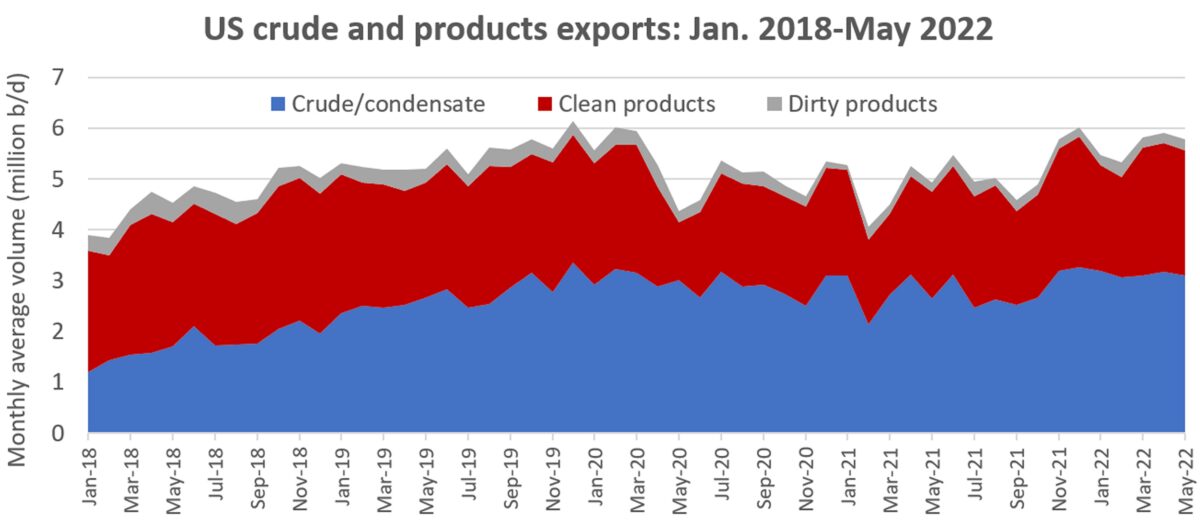U.S. energy exports are booming at the very time domestic gasoline and diesel prices are at or near their peaks. With America’s fuel prices expected to rise even further, the “resource nationalism” debate — should we be exporting commodities we need? — is heating up.
According to new tanker cargo volume data from Kpler, U.S. crude exports averaged 3.13 million barrels/day (b/d) in January-May. That’s the best first five months of the year ever. Exports of clean petroleum products — including the diesel and gasoline in such high demand domestically — averaged 2.32 million b/d. That’s the best first five months since 2019, pre-COVID.

U.S. gasoline, diesel and jet fuel markets are tight because seaborne exports are now strong whereas U.S. refining capacity is down 860,000 b/d relative to late 2019, Reid I’Anson, senior commodity analyst at Kpler, told American Shipper.
“This is a textbook case of a refinery sector that is running hard and yet does not have the capacity to meet demand,” he said. “This is not a problem easily fixed.”
Where are US exports going?
Given Monday’s EU decision to ban tanker imports of Russian crude and products, U.S. crude and products exports to Europe are expected to rise. A portion of the U.S. Strategic Petroleum Reserve release is already heading to Europe. Crude flows to Europe “have definitely picked up,” said I’Anson.
European imports from the U.S. were 1.27 million b/d in May, “a record high, accounting for 40% of all imported U.S. barrels, with volumes [favoring] the Netherlands, Spain and Italy. This has come at the expense of barrels into India, Canada and South Korea.”
U.S. clean products exports are still overwhelmingly headed to Latin America. According to Kpler data, Latin America accounted for 2.15 million b/d, or 87%, of all U.S. seaborne imports to any destination in May.
“It is still possible that trade flows shift with more U.S. products heading to Europe,” said I’Anson. “I think the reason we haven’t seen more of a shift yet is the fact that Russian clean and dirty [petroleum products] arrivals into the EU-27 have remained consistent — that is, until recently.
“In May, seaborne offtakes [from Russia were] 1.28 million b/d, down 155,000 b/d against January, before the invasion of Ukraine had begun. So, U.S. products could find more attractive bids into Europe, especially as embargoes come into force.”
Resource nationalism grows
Europe’s war-heightened demand for U.S. petroleum combined with America’s COVID-reduced refining capacity might lead some to ask: Why not curb exports and keep the oil in America?
Resource nationalism is on the rise globally. Most recently, India has introduced export restrictions for wheat, Indonesia for palm oil and Malaysia for chickens. China has reduced export quotas for gasoline, diesel and jet fuel.
Last week, Energy Secretary Jennifer Granholm was asked whether U.S. oil export restrictions were a possibility. She replied, “I can confirm the president is not taking any tools off the table.”
Stifel shipping analyst Ben Nolan said of Granholm’s comment: “Hopefully, this was simple political positioning in a midterm election year. Because if not, we think it represents significant unawareness regarding the very sector being overseen.”
If there is a ban, “the implications for the U.S. oil and gas industry and the global economy would be extremely negative,” Nolan said in a new client note. A ban would cause “a sharp increase in the price of crude internationally, inevitably weakening the global economy.”
A resultant drop in U.S. oil drilling would cause “a sharp fall in natural gas production … very likely leading to limiting LNG [liquefied natural gas] exports at the very time the world needs the gas more than ever.”
Potential fallout
The U.S. banned crude exports to countries other than Canada between 1975 and the end of 2015.
In November 2021, long before the recent price surge, 11 senators asked President Joe Biden to “consider all tools available at your disposal to lower U.S. gasoline prices … [including] a ban on crude oil exports.”
At that time, IHS Markit, now a part of S&P Global (NYS: SPGI), warned what would happen if the export ban was reinstated.
The price of U.S. gasoline is connected to global crude and gasoline prices, not the price of domestically produced crude, argued IHS Markit. Also, most U.S. refinery capacity is not geared to handle light, sweet blends now produced in the U.S. That necessitates exports.
Banning crude exports would “discourage domestic production” and “set off a scramble for supply” that would increase the global crude price. The net effect would be “upward pressure on U.S. gasoline prices.”
Asked for an update of this position — and what a hypothetical ban on U.S. gasoline or diesel exports would mean — Kurt Barrow of S&P Global Commodity Insights told American Shipper: “Banning crude oil exports from the U.S. remains a poor policy choice with several potential unintended consequences. The market dynamics that lead to higher gasoline prices from a crude oil ban described in our media release of November … would continue to apply but in an amplified way given today’s extraordinarily tight oil markets.
“Banning refined product exports would also have the real possibility of causing unintended shortages and higher, not lower, gasoline and diesel prices in certain parts of the U.S. market that rely, due to logistical reasons, on product imports from our allies in Europe and Canada.”
Click for more articles by Greg Miller
Related articles:
- Ship fuel enters uncharted territory as prices hit new wartime peak
- Russia tanker business is alive and well. Oil exports ‘remain strong’
- The world is ‘crying out for diesel.’ Product tankers could win big
- Can tanker imports save drivers from spiking summer gasoline prices?
- Gimme shelter: Shipping stocks still rising amid Wall Street storm
- Shipping isn’t waiting for sanctions. It’s refusing to move Russian cargo







